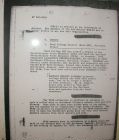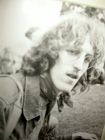The popular Emerson Gallery exhibit "1968: You Say You Want a Revolution" has inspired many of its visitors to take a step back in time and remember what THEY were doing in 1968. Around the Hill asked some Hamilton employees to share their memories of the year marked by the assassinations of Martin Luther King, Jr. and Robert Kennedy, riots in urban ghettoes and the massacre at My Lai.
Monk Rowe, the Joe Williams Director of the Jazz Archive, says: "In 1968 I thought my future path was set. I had played saxophone in an all-county jazz band led by Chuck Mangione, graduated from Irondequoit High School and was headed to SUNY Fredonia as a music major. During that summer, I was making a couple of dollars an hour sweeping floors in a button factory, meanwhile listening constantly to Cannonball Adderley, John Coltrane and the Buddy Rich Big Band. The changes in the air and the turmoil of that year seemed far away from suburban Rochester and only became personal when the first draft lottery took place. There was a huge crowd of nervous guys crowded around the one television set in our dorm."
The copies of Life Magazine on display at the Emerson "1968" exhibit are on loan from Monk's mother, Bette Rowe, who kept them as mementos of the year Monk graduated from high school. Monk's daughter, Janine '06, was one of the student curators of the exhibit.
"The 1968 exhibit in Emerson really brought back memories, and my wife, Romy, and I were thrilled that our daughter Janine played a role in it," said Monk. "It was very cool that the magazines and newspapers my mother had saved in 1968 finally saw the light of day. It also made me wonder why those tumultuous events did not make a bigger impression at the time. I guess we rarely realize when we are seeing history in the making," Monk noted.
 |
From the mouths of babes, Colleen Amarose, Emerson Gallery assistant, recalls, "I was a young girl living in Massachusetts in 1968." She said, "When Robert Kennedy was shot, my younger sisters and I organized a protest march -- in our back yard. We made signs and marched around yelling 'No More Killing!' I think my parents were mortified."
Diann Lynch, Student Health Services nurse, said, "I visited the exhibit before winter break and was fascinated by it. It brought back a flood of memories of that time of my life. In 1968, I was working and applying to nursing schools," Diann recalled. "Since my boyfriend at the time was protesting the war after returning from a tour in Vietnam, I became involved in some anti-war activities. I guess I was sort of a hippie type.......had all the granny dresses, with matching glasses and peace jewelry, had long straight hair held in place with peace headbands! It was an exciting time of my life that I would not change for anything."
 |
Associate Professor of Russian Frank Sciacca, who is teaching the "1968" sophomore seminar, said "1968! That fall I entered Columbia College--just months after the spring student strike that shut down the university. The campus was still charged with the energy of the strike," he recalled. "Within the first month of my arrival I participated in my first march (down Broadway) in opposition to the war in Vietnam. "Soon thereafter," Frank said, "the hair started to grow longer and the jeans started to sprout patches (they are on exhibit in the Emerson Galley show until Feb. 15). I've never regretted my decision to enroll at Columbia-- despite the pleadings of my high school counselor to reconsider after the 'rebellion' erupted.
Lynn "Mort" Morton, mail clerk, spent a year in Vietnam. Even though his friends at home were protesting the war, Mort enlisted in the Air Force. "We were told that we were in Vietnam to stop Communism," he said. When asked about the anti-war movement that was in full swing when he returned to the U.S., Mort said, "It took about five years for me to realize how pointless it was for us to be over there."
Professor of Comparative Literature and Kirkland Project director Nancy Rabinowitz said, "I feel that I was always in the wrong place--when the students were sitting in at Columbia, I was in Chicago; when the students were sitting in at Chicago, I was working. But I was at marches on Washington and in downtown Chicago protesting the war!"
In 1968, Maurice Isserman, professor of history, entered Reed College as a freshman and joined the SDS (Students for Democratic Society.) He spent the next several years trying to overthrow the capitalist state. He regrets to inform us that he failed.
From an interview he gave to an Emerson Gallery student curator, we learn that Maurice and a group of his friends from the Portland Revolutionary Youth Movement (PRYM) leased a house together and set-up a communal living arrangement. In founding PRYM they modeled their group on the decentralized, local organizations of the civil rights movement, rather than the centralized disciplined parties of the Leninist Left. PRYM activities were characterized by "a lot of confusion and leaderlessness, " he recalls. Maurice and other PRYM members printed and sold their own "underground" newspaper, worked at a local food cooperative, as well as at other counterculture alternative institutions.
 |
Maurice and his friends suspected they were under FBI surveillance, although they had no proof at the time that this was the case. The only direct contact Isserman says he had with a "black-tied, black-coated, black-shiny-shoes-wearing" agent was after a bomb exploded in the city court building in Portland. Maurice's FBI file is part of the "You Say You Want a Revolution" exhibit at Emerson Gallery.
Posted February 4, 2004


